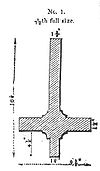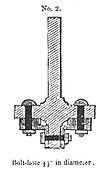
Wooton bridge collapse
Encyclopedia
The Wootton bridge collapse occurred on 11 June 1861, when the rail bridge at Wootton
collapsed under the weight of a passing goods train on the line between Leamington Spa
and Kenilworth
owned by the London and North Western Railway
Company. The train had passed over the bridge safely in the morning with a full load of coal, and was returning to Kenilworth with the empty wagons at 7 am. The 30 ton locomotive fell through the deck of the bridge onto the road below, and the tender crashed into the cab, killing both driver and fireman instantly. Many of the empty wagons behind were dragged into the gap to form a pile almost up to the height of nearby telegraph poles.

 Henry Whatley Tyler
Henry Whatley Tyler
of the Railway Inspectorate examined the accident on behalf of the Board of Trade
. He reported that the five cast iron girders which supported the base of the wooden bridge had all fractured near their centres, and so caused the accident. One in particular had been mended some years before, and he thought that the failure had started here. Angle iron had been fitted along the girder to support a crack in the flange, and had been bolted onto the cast iron. Far from strengthening the girder it had actually weakened it further. In hindsight, it is likely that cracks in the girders had grown to a critical size during the initial passage of the heavy train, which then gave way when the empty train returned.
of 1847, when another cast iron bridge had failed. Cast iron should not have been used in this safety-critical application, and the design seems very strange, using cast iron where timber baulks would have sufficed. The bridge had been built in 1844, well before the Dee accident, and patched with the angle iron in 1853. The discovery of the cracked girder should have alerted engineers to the problem, and all should have been replaced entirely. Cast iron failures remained a problem for many years, culminating in the fall of the Tay Rail Bridge
in December, 1879 with over 75 casualties in the passenger express passing over the viaduct at the time the cast iron columns collapsed. The problem did not end there, however, because so much cast iron had been used on the rail network. A cast iron under-bridge failed suddenly under a train during the Inverythan crash in 1882, killing 5 passengers on the train. The event which really focused minds occurred in 1891, when another girder failed under the Brighton express. Although no-one was killed, the furore caused by the Norwood Junction rail accident
led to a survey of all under-bridges. Several thousand were eventually found, and ultimately strengthened or replaced.
Leek Wootton
Leek Wootton is a village in Warwickshire, England, roughly one mile from Kenilworth and two miles from Warwick. It lies in the triangle created by Kenilworth, Warwick and Leamington Spa.-Geography:...
collapsed under the weight of a passing goods train on the line between Leamington Spa
Leamington Spa
Royal Leamington Spa, commonly known as Leamington Spa or Leamington or Leam to locals, is a spa town in central Warwickshire, England. Formerly known as Leamington Priors, its expansion began following the popularisation of the medicinal qualities of its water by Dr Kerr in 1784, and by Dr Lambe...
and Kenilworth
Kenilworth
Kenilworth is a town in central Warwickshire, England. In 2001 the town had a population of 22,582 . It is situated south of Coventry, north of Warwick and northwest of London....
owned by the London and North Western Railway
London and North Western Railway
The London and North Western Railway was a British railway company between 1846 and 1922. It was created by the merger of three companies – the Grand Junction Railway, the London and Birmingham Railway and the Manchester and Birmingham Railway...
Company. The train had passed over the bridge safely in the morning with a full load of coal, and was returning to Kenilworth with the empty wagons at 7 am. The 30 ton locomotive fell through the deck of the bridge onto the road below, and the tender crashed into the cab, killing both driver and fireman instantly. Many of the empty wagons behind were dragged into the gap to form a pile almost up to the height of nearby telegraph poles.
Investigation


Henry Whatley Tyler
Sir Henry Whatley Tyler was a British Inspector of Railways, Railway Company director and Conservative politician who sat in the House of Commons from 1880 to 1892.-Early life:...
of the Railway Inspectorate examined the accident on behalf of the Board of Trade
Board of Trade
The Board of Trade is a committee of the Privy Council of the United Kingdom, originating as a committee of inquiry in the 17th century and evolving gradually into a government department with a diverse range of functions...
. He reported that the five cast iron girders which supported the base of the wooden bridge had all fractured near their centres, and so caused the accident. One in particular had been mended some years before, and he thought that the failure had started here. Angle iron had been fitted along the girder to support a crack in the flange, and had been bolted onto the cast iron. Far from strengthening the girder it had actually weakened it further. In hindsight, it is likely that cracks in the girders had grown to a critical size during the initial passage of the heavy train, which then gave way when the empty train returned.
Similar accidents
It is memorable for coming after the Dee bridge disasterDee bridge disaster
The Dee bridge disaster was a rail accident that occurred on 24 May 1847 in Chester with five fatalities.A new bridge across the River Dee was needed for the Chester and Holyhead Railway, a project planned in the 1840s for the expanding British railway system. It was built using cast iron girders,...
of 1847, when another cast iron bridge had failed. Cast iron should not have been used in this safety-critical application, and the design seems very strange, using cast iron where timber baulks would have sufficed. The bridge had been built in 1844, well before the Dee accident, and patched with the angle iron in 1853. The discovery of the cracked girder should have alerted engineers to the problem, and all should have been replaced entirely. Cast iron failures remained a problem for many years, culminating in the fall of the Tay Rail Bridge
Tay Rail Bridge
The Tay Bridge is a railway bridge approximately two and a quarter miles long that spans the Firth of Tay in Scotland, between the city of Dundee and the suburb of Wormit in Fife ....
in December, 1879 with over 75 casualties in the passenger express passing over the viaduct at the time the cast iron columns collapsed. The problem did not end there, however, because so much cast iron had been used on the rail network. A cast iron under-bridge failed suddenly under a train during the Inverythan crash in 1882, killing 5 passengers on the train. The event which really focused minds occurred in 1891, when another girder failed under the Brighton express. Although no-one was killed, the furore caused by the Norwood Junction rail accident
Norwood Junction rail accident
The Norwood Junction railway crash occurred on 1 May 1891, when a cast iron under-bridge some 60 yards north east of Norwood Junction railway station fractured under an express train from Brighton to London in southern England....
led to a survey of all under-bridges. Several thousand were eventually found, and ultimately strengthened or replaced.
External links
- Full report from the Railway Archive
- Discussion of bridge failures in Britain

